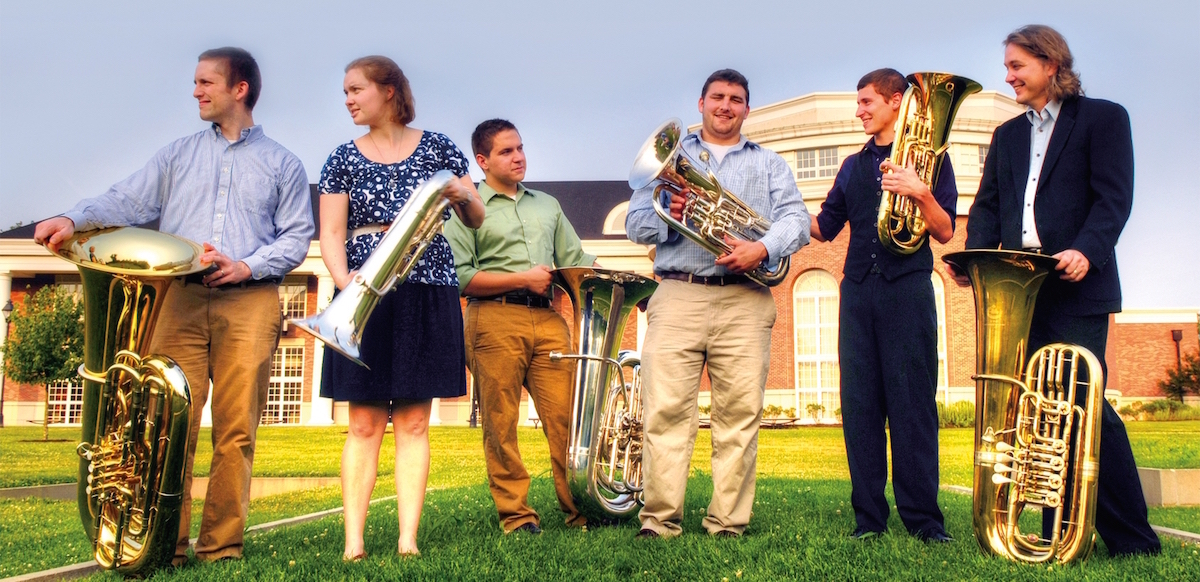Culture

Top Brass: OU Tuba Ensemble Hits Unexpected Notes
By: Andrea Gibson
Posted on:
Think of tubas, and the image of a musician in a marching band exhaling the sound of “oompah, oompah” might come to mind. But that’s not what audiences experience at a performance of Ohio University’s Tuba-Euphonium Ensemble, a unique collective of undergraduate and graduate students who enjoy defying the expectations of these large, low-pitched brass instruments.
“How often do you hear about a tuba ensemble?” asks student musician Jordan VonWahlde. “Even for tuba players, it’s unusual.”
The Tuba-Euphonium Ensemble is the brainchild of Jason Smith, an internationally renowned faculty member in the School of Music. Ohio University hired him in 1999 as the school’s first full-time tuba-euphonium professor, which allowed the school to form the faculty brass quintet OhioBrass.
When Smith first arrived on campus, there were only three tuba students. An active recruiter of high school musicians, he now mentors about 15 students—often music education, music therapy, or performance majors—per year. The student ensemble has performed at two international tuba-euphonium conferences, as well as the Midwest Tuba-Euphonium Conference.
The growth of the program mirrors a musical trend. Based on the popularity of the New York Brass Quintet, universities began hiring tuba-euphonium professors in the late 1950s to start their own ensembles. A growth in tuba-euphonium majors followed, and by 1973, the International Tuba Euphonium Association was formed.
The community remains a close-knit group. “It’s hard to find any tuba player on the planet that I haven’t had some contact with,” says Smith, the editor of the globe’s only scholarly tuba-euphonium publication, the International Tuba Euphonium Journal.
The Ohio University students who play in Smith’s Tuba-Euphonium Ensemble also say they enjoy the camaraderie that comes with membership in the world of these unique instruments. There’s often a common recruitment story: A high school band director appeals to a trumpet or trombone player to make the switch to the larger tuba (or its smaller relative, the euphonium). VonWahlde says that there can be a stigma attached to the tuba, as some musicians perceive that the assignment is given to students who can’t hack other instruments.
“The idea that it’s just for the inadequate musicians is a knock against the tuba in general,” says VonWahlde, a senior from Westchester, Ohio. “I’d like to change that mentality.”
Once musicians become acclimated to the tuba or euphonium, they often discover that the instruments are far more musical than they anticipated.
“There’s so much music out there for it that’s different and interesting,” says Carolyn Milbaugh, a junior from Lancaster, Ohio, who previously played flute.
Smith’s ensemble pushes students to get creative with the instruments. Each spring, he assigns the students to adapt a piece of music for tuba or euphonium. VonWahlde chose “It Takes Four to Tango,” originally written for a bassoon quartet.
“It’s a really cool experience. We get an opportunity to understand what does and doesn’t work,” he says.
Not every piece lends itself to these baritone instruments – “you wouldn’t play lush, romantic orchestral string music with a tuba ensemble,” VonWahlde notes — but when it does work, the ensemble can evoke a rich, dark tone that can surprise audiences.
“The best comment we get is, ‘I didn’t know tubas could do that,’” Smith says of the instrument’s unexpected versatility.
The students also stretch their expectations of their own musical capabilities. Nathan Cain, a junior from Springboro, Ohio, notes that Smith’s in-depth expertise with the instruments helped him refine his techniques.
“There’s a lot that he’s taught me that I never thought about before,” says Cain, who is also the head of the euphonium section of the university’s famed Marching 110.
Developing arrangements and playing with the Tuba-Euphonium Ensemble is good preparation for careers in music education and therapy, the students say. As for those high school band musicians destined for the role of tuba player? They’ve got a generation of future band directors at Ohio University determined to make them the coolest kids in the room.
The ensemble will celebrate “Octubafest” with a performance at 8 p.m. Tuesday, Oct. 18, in Ohio University’s School of Music Recital Hall.
This article will appear in the Autumn/Winter 2011 issue of Perspectives magazine, which covers the research, scholarship, and creative activity of Ohio University faculty, staff, and students. Follow Ohio University Research News on Twitter and Facebook.

